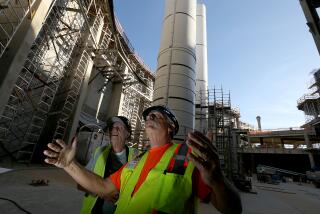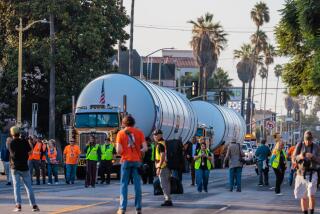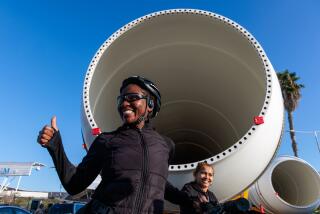NASA Gives Shuttle Job to Lockheed : $1.1-Billion Contract Calls for Building of New Rocket Boosters
- Share via
CAPE CANAVERAL, Fla. — Lockheed Missile Systems Division won contracts worth more than $1 billion to build new space shuttle solid rocket boosters at an abandoned nuclear power plant in Mississippi, NASA announced today.
The total cost for the controversial seven-year project, which calls for design, development and testing of the new advanced solid rocket motor, or ASRM, along with construction of new manufacturing facilities, was estimated by Lockheed of Sunnyvale, Calif., to be more than $1.1 billion.
“The precise values of both contracts will be determined in negotiations between NASA and Lockheed,” The National Aeronautics and Space Administration said in a statement.
The booster contract includes an option for production of up to 44 booster sets with the new motors in time for first flight in 1994. The Lockheed boosters will be phased in over the next three years, replacing the current rockets built by Morton Thiokol Inc. of Brigham City, Utah.
The new boosters will be built at the Tennessee Valley Authority’s vacant nuclear power plant in Tishomingo County, Miss. A total of 1,400 people are expected to be employed.
“We are pleased that this important step has been taken in the process for the construction of this facility,” Sens. Thad Cochran and Trent Lott, both Mississippi Republicans, said in a statement issued in Washington.
Aerojet Is Subcontractor
Lockheed’s principal subcontractor for the project will be Aerojet Solid Propulsion Co. of Sacramento. Lockheed won the contract over Hercules Inc. of Magna, Utah, and Atlantic Research Corp. of Gainesville, Va., which submitted a proposal under the name Hercules-Atlantic.
Other members of the Lockheed team include Babcox and Wilcox of Barberton, Ohio, Morton Thiokol, Lockheed Austin Division of Austin, Tex., and Rust International of Birmingham, Ala., which will be facilities contractor.
The advanced solid rocket motor was proposed after the Jan. 28, 1986, Challenger disaster that killed seven astronauts. A faulty O-ring seal in the ship’s right-side booster was blamed for the shuttle’s destruction.
The boosters, built by Morton Thiokol, were redesigned after the disaster to make them less susceptible to failure. NASA began exploring alternate designs about the same time, and the result was the ASRM program.
The project faces funding problems and questions in Congress, however, because of an internal NASA safety board report that challenged the need for a more powerful solid-fuel rocket to launch the space shuttle.
Critics say proceeding with the project implies that the current boosters, redesigned at a cost of more than $600 million, are unsafe. In addition, they say, conservative post-Challenger flight rules limit how much weight a shuttle can carry into orbit, making the excess performance of the ASRM unnecessary.
More to Read
Inside the business of entertainment
The Wide Shot brings you news, analysis and insights on everything from streaming wars to production — and what it all means for the future.
You may occasionally receive promotional content from the Los Angeles Times.










